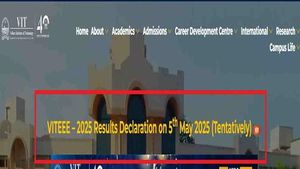In a striking contrast to its size and economic power, Texas ranks 11th in the nation for access to early childhood education for 4-year-olds and 15th for 3-year-olds, according to a 2024 report released by the National Institute for Early Education Research (NIEER) on April 29, 2025. This report reveals that while Texas has made strides in preschool enrollment, significant gaps in funding and quality persist.
For the 2023-24 school year, a total of 248,371 children were enrolled in preschool programs across Texas. However, U.S. Census data indicates there are nearly two million children under the age of five in the state, suggesting that access to early education remains limited. The enrollment figures show that 11% of 3-year-olds and 52% of 4-year-olds are participating in some form of early childhood education, placing Texas among the top 20 states for accessibility.
Despite these numbers, Texas's spending on early childhood education paints a less favorable picture. The state invests approximately $4,682 per child enrolled in preschool, including federal funds, while the estimated cost of providing a "high-quality" preschool experience is around $13,780 annually. This spending is a decrease from $5,696 per child in 2002, raising concerns about the long-term viability of preschool programs.
Allison Friedman-Krauss, a researcher and associate professor at NIEER, highlighted that states often prioritize funding for preschool programs for 4-year-olds over 3-year-olds, as the former is less costly. “Attending a quality program for two years rather than one is associated with larger impacts and a larger long-term impact on children,” she stated. Yet, only a handful of states offer universal preschool for both age groups.
In Texas, 91% of school districts offer preschool programs, indicating a strong commitment to early education. However, cities like San Antonio, which has implemented the Pre-K 4 SA program, face challenges in meeting the demand for child care. According to Sarah Baray, CEO of Pre-K 4 SA, the city-funded initiative aims to provide low-cost preschool for children ages 3 and 4. Unfortunately, a study conducted by Texas A&M University-San Antonio found that child care providers in San Antonio were licensed for 30% more slots than were actually available last year, resulting in a deficit of 20,000 child care slots.
Baray emphasized the implications of this shortage, stating, “It’s an issue for the children, but also for the workforce.” Employers often consider the availability of child care when deciding to establish new operations in an area, making access to early education a critical economic factor.
To qualify for publicly funded pre-K in Texas, children must meet certain criteria, including being eligible for free or reduced lunch, being homeless or in foster care, or being an English learner. Texas has provided funding for preschool since 1985, starting with half-day programs for eligible 4-year-olds. The state expanded its commitment in 2019 with House Bill 3, which allocated funds for full-day pre-K, and in 2023, lawmakers eased qualifications for teachers in nonpublic preschool programs through House Bill 2729.
However, this rollback has raised concerns regarding quality. Texas only met two out of ten benchmarks established by NIEER for high-quality preschool programs, specifically regarding learning standards and health screenings. Friedman-Krauss remarked, “When states are only meeting two standards and policy, we’re pretty sure they’re not meeting a quality program.”
In total, Texas allocated slightly more than $1 billion for early childhood education during the 2023-24 cycle, supported by $2.4 million in federal funding. The federally funded Head Start program, which serves low-income families, accounted for roughly 50,000 students, or 6% of total preschool enrollment in Texas. In San Antonio alone, Head Start served approximately 3,265 children during the same school year.
Despite the state’s investments, the future of programs like Head Start remains uncertain, particularly with proposed cuts from the Trump administration that could impact funding for early education initiatives. Friedman-Krauss warned that such cuts could jeopardize access for many families, stating, “Texas increasing spending, improving quality — that really can move the needle at a national level.”
Meanwhile, Utah faces its own challenges in early childhood education, ranking last for 4-year-olds and 30th for 3-year-olds in state-funded preschool programs, according to the same NIEER report. The state’s High Quality School Readiness program, which serves children facing risk factors, has only managed to enroll about 2,000 children, representing just 2% of 3-year-olds and 3% of 4-year-olds in the state.
Jared Lisonbee, a preschool education specialist with the Utah State Board of Education, noted that while the state has made progress in meeting six of the ten quality criteria set by NIEER, it still has a long way to go. “They have a long way to go to really be at the level of what we would consider a quality program that we can really expect to support child learning,” Friedman-Krauss added.
Funding remains a significant barrier in Utah, which currently receives $6 million from state funds and $6 million from federal sources, with an additional $2 million boost from federal Temporary Assistance for Needy Families funds over the next three years. However, Lisonbee emphasized that this funding is insufficient to meet the needs of all eligible children, estimating that $24 million would be required to fund every qualifying child.
Additionally, the program does not meet four key quality standards, including requiring that lead teachers hold a bachelor’s degree and that staff undergo necessary professional development. “We would need to receive additional funding in order for programs to provide pay to staff that would justify, or that would require, the bachelor's degree,” Lisonbee explained.
As both Texas and Utah navigate their respective challenges in early childhood education, the findings from the NIEER report underscore the importance of continued investment and policy reform to ensure that all children have access to high-quality preschool programs. With both states facing funding constraints and varying levels of program quality, the call for action becomes increasingly urgent.





